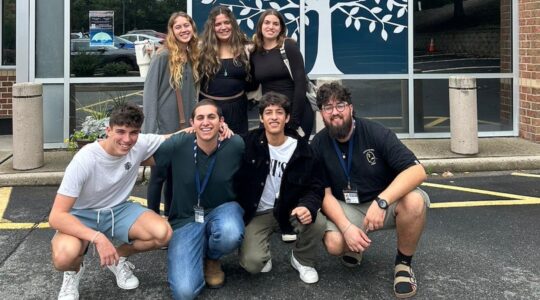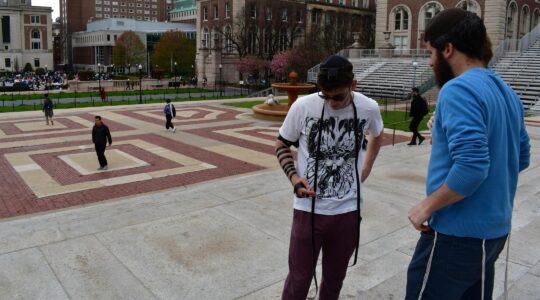STAMFORD, Conn. (JTA) – Is it permissible for an Orthodox family to play host to a Jewish couple if they don’t observe laws mandating sexual abstinence in the period surrounding menstruation?
That was among the questions posed to two leading rabbinic authorities last week at the 85th national convention of Agudath Israel of America, the main umbrella body for fervently Orthodox, or haredi, Jewry.
The answer: It is, if the room has two beds.
The session, titled “Kosher Kiruv: Halachic Do’s and Don’ts,” was part of a broad push to make kiruv, or outreach to nonobservant Jews, a mainstay among the rank-and-file of haredim.
At a plenary session titled “American Jewry at Cliff’s Edge,” speakers cited worrisome statistics about American Jewish assimilation and stressed the responsibility of individuals to support efforts to help draw nonobservant Jews closer to their heritage.
“The cause of the spiritual Holocaust of the Jewish people isn’t as much assimilation as it is ignorance,” said Antony (Chanan) Gordon, a Harvard law school-educated hedge fund manager from Los Angeles who persuaded the Agudah leadership to make kiruv the convention theme.
“Essentially what we want the Orthodox world to hear from Torah authorities is that the time has come where we have to galvanize our forces and do what we can to spearhead a solution to what’s clearly a well-known problem in America,” he said.
While Gordon and others say the emphasis on kiruv is a path-breaking change for the Agudah crowd, an insular community mostly centered in a handful of close-knit enclaves in New York and New Jersey, kiruv in fact has been on the Agudah agenda for more than three decades.
After the group’s 1974 convention, Agudah founded the Jewish Education Program, which brought Jewish students from public schools to nearby yeshivas for religious instruction.
At the group’s 2004 conclave, Agudah’s executive director, Rabbi Shmuel Bloom, noting demographic trends showing that Orthodox Jews represent a growing percentage of an otherwise shrinking Jewish community, said Agudah constituents needed to take on greater responsibility for communal concerns that typically had been left to secular Jewish institutions.
Bloom told JTA that this latest initiative reflects an urgent need to bolster efforts that have long been under way. But others say the convention theme suggests that the kiruv message has not permeated the rank-and-file.
“There seems to be a little bit of a disconnect between what the message that I think they have been giving and what the strictly Orthodox community has perceived, or at least has picked up on,” Rabbi Eli Gewirtz told JTA.
Gewirtz, who lives in New Jersey and runs a program that matches up nonobservant Jews with telephone study partners, was one of a handful of so-called “kiruv professionals” at the convention.
“It has not really filtered down in a very, very significant way,” he said.
Gordon, who chaired an outreach conference earlier this year in Baltimore, said he believes the new initiative could portend a potentially historic shift because of the collaboration between outreach professionals and Agudah’s religious leadership, which retains overall authority over the organization’s policies.
“We’ve never had the greatest sages and the most respected authorities in the Orthodox world articulating very unequivocally that this is an obligation and a call to action of not only activists and people who have a propensity to reach out to others,” Gordon said. “This is every single person’s obligation in the Orthodox world, so I think that’s a distinction.”
While the success of the new outreach initiative remains to be seen, the rhetoric alone suggests a growing self-confidence on the part of the fervently Orthodox. Statistics show that haredim are growing as a percentage of American Jews and retain their young people at rates that dwarf those of modern Orthodoxy.
A widely cited study co-authored by Gordon predicted that on average, 100 haredim will yield 3,401 haredim after four generations, compared to 434 for modern Orthodox Jews. The same 100 Conservative and Reform Jews will produce 29 and 10, respectively, according to the study.
Aharon Ungar, the author of a book on kiruv techniques that was distributed to conference attendees, said Agudah’s earlier focus on its own communal priorities reflected a mentality of “galus,” or exile.
“Now the Jewish community as a whole is very strong and the religious community is very strong as well,” Ungar said. “So the religious community now has the ability – both the wealth, the knowledge and the leadership – to go beyond our own circle-the-wagons mentality. That’s why it’s something new now. We’ve only reached this point in this generation.”
Agudah’s kiruv efforts had focused on its education program and so-called community kollelim – small groups of young men paid to study Torah full-time in an outlying area.
Agudah aims to make kiruv more of a grassroots concern, though for now the initiative is short on specifics. The sole kiruv-related outcome of the conference was the establishment of an executive committee charged with hashing out the details of an outreach plan.
“The Agudah is not going to start a new kiruv organization; we’re not going to become a kiruv organization,” Bloom told JTA. “What we’re attempting to explain to our constituency is that they have to work with all the existing kiruv organizations to use their talents and their abilities, to volunteer to expand the effort. And we think that this is the right time for that.”





